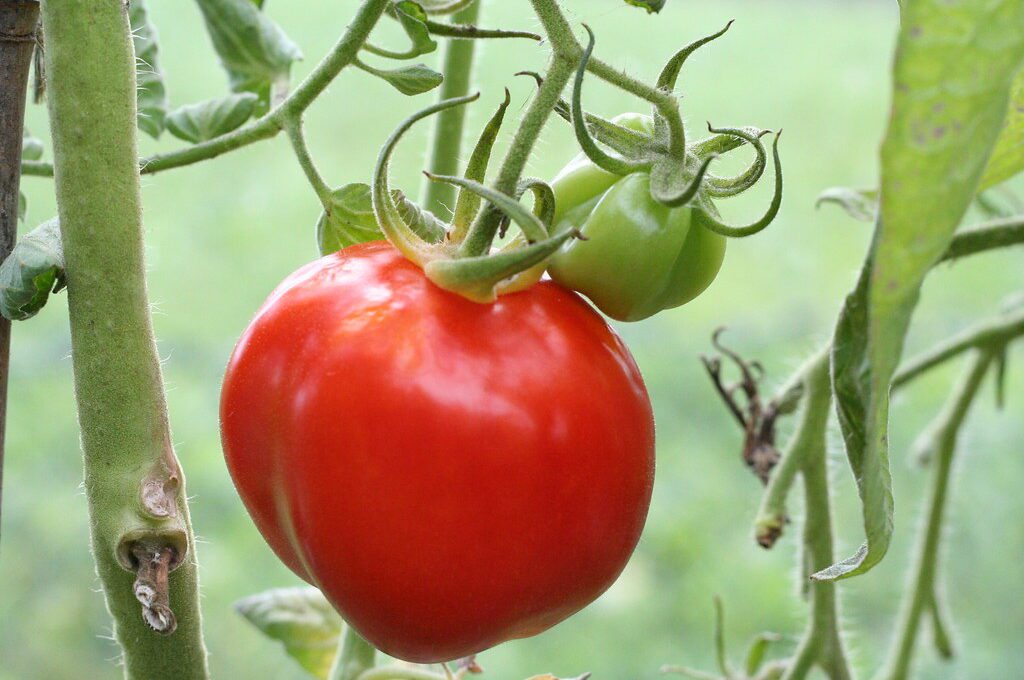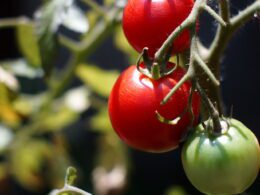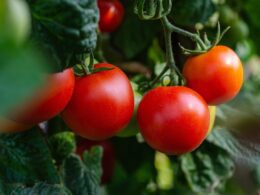You may think that in sweltering hot weather, your tomato plants can’t get enough water. While it’s true that these sun-loving vegetables need plenty of hydration to thrive, there is such a thing as too much of a good thing.
Overwatering can lead to various problems for your tomato plants, and it’s essential to strike the right balance – even during those scorching summer days.
In this article, we’ll dive into the world of watering tomato plants during hot weather. We’ll discuss how to recognize signs of overwatering, explore the consequences of giving them too much H2O, and provide tips on maintaining proper moisture levels when temperatures soar.
So buckle up and let us guide you toward healthier, happier tomato plants that will have you enjoying a bountiful harvest while keeping your green thumb safe from any potential pitfalls!
Understanding Tomato Plant Water Requirements
It’s crucial to grasp your precious tomatoes’ hydration needs, as striking the right balance can make all the difference between a bountiful harvest and a disappointing one. Tomato plants thrive on consistent moisture levels in their soil, which is key to producing those juicy, delicious fruits you dream of.
To ensure your plants get just the right amount of water, pay attention to factors such as temperature, sunlight exposure, and humidity. When it comes to watering tomato plants during hot weather, you need to be extra cautious. As temperatures rise above 85°F (29°C), tomato plants may experience stress due to excessive heat and increased evaporation rates.
This means that they’ll require more frequent watering than usual. To maintain optimal soil moisture levels for healthy growth, consider watering deeply in the early morning or late afternoon when temperatures are cooler and less water will evaporate. Monitoring your tomato plants closely and adjusting your watering schedule based on weather conditions can greatly improve their overall health and productivity.
A good rule of thumb is checking the top inch of soil daily; if it feels dry or crumbly to touch, it’s time for a thorough soak. By being attentive to your tomatoes’ changing needs in hot weather and providing them with adequate water at appropriate intervals, you’ll be well on your way toward an abundant harvest that’s both safe and satisfying for you and your family.
Signs of Over Watering Tomato Plants
In scorching conditions, it’s crucial to recognize if you’re giving your tomatoes too much H2O. Overwatering can lead to several issues, including root rot and nutrient deficiency. To ensure the well-being of your tomato plants, it’s essential to keep an eye out for signs that they might be receiving more water than they need.
Here are some symptoms of overwatered tomato plants:
-
Yellowing leaves: This could indicate a lack of oxygen due to waterlogged roots
-
Wilting despite wet soil: A clear sign that the plant is not getting enough oxygen from the roots
-
Root rot: When roots become mushy and dark-colored due to excess moisture
-
Blossom end rot: A calcium deficiency caused by uneven watering leading to black spots at the bottom of the fruit
To prevent these issues from occurring in hot weather, make sure you monitor your plants closely. Check their soil regularly and adjust your watering schedule as needed.
If you notice any of these signs, reduce the amount of water immediately and allow the soil to dry out slightly before resuming regular watering practices. It may also help to add organic matter or mulch around the base of your plants to improve drainage and retain moisture more evenly.
By keeping a close eye on your tomato plants during hot weather and adjusting their care accordingly, you’ll be able to enjoy a bountiful harvest without worrying about overwatering-related problems. And remember – when it comes to caring for tomato plants in extreme heat, prevention is always better than cure!
So stay vigilant and keep those tomatoes happy and healthy all summer long.
Consequences of Over Watering
Let’s dive into the consequences of overwatering your tomato plants. There are three key points to focus on: reduced fruit production, increased susceptibility to disease, and nutrient leaching.
By understanding these issues, you’ll be better equipped to maintain a healthy garden and maximize your tomato harvest. So, grab your gardening gloves and let’s explore these potential pitfalls together!
Reduced fruit production
Believe it or not, excessive hydration could actually lead to diminished fruit yields in scorching temperatures! When you overwater your tomato plants during hot weather, it causes the plant to focus on producing foliage instead of fruit.
In other words, you might end up with a lush green plant but with fewer tomatoes than you expected. To avoid this issue, make sure you’re monitoring your tomato plants closely and adjusting their water intake as needed.
Keep an eye out for signs of overwatering like yellow leaves or wilted foliage. By finding that sweet spot between too much and too little water, you’ll be able to enjoy a bountiful harvest without sacrificing the safety and health of your precious tomato plants.
Increased susceptibility to disease
It’s true that too much hydration can leave your precious garden gems more vulnerable to diseases, especially during sweltering temperatures. Over-watering your tomato plants in hot weather creates the perfect environment for pathogens to thrive and attack your plants. The excess moisture combined with high temperatures encourages the growth of harmful fungi and bacteria, which can quickly spread throughout your garden.
To keep your tomato plants healthy and safe from diseases, consider these three simple tips:
-
Water at the base: Always water your tomato plants at their base instead of overhead watering. This prevents water from sitting on leaves, which can lead to fungal infections.
-
Monitor soil moisture: Check the soil moisture regularly using a moisture meter or by simply sticking a finger into the soil about an inch deep. If it feels moist at that depth, hold off on watering until it dries out slightly.
-
Improve air circulation: Ensure adequate spacing between your tomato plants to promote better airflow and reduce humidity levels around them.
By following these steps, you’ll not only protect your beloved tomatoes from over-watering but also create a safer growing environment that discourages disease development in hot weather conditions.
Nutrient leaching
Imagine soaking your garden too much during sweltering summer days, causing essential nutrients to leach away from your precious tomato plants. This not only weakens the plants but also deprives them of the necessary nutrients for healthy growth and production.
Overwatering in hot weather can lead to a rapid loss of valuable nutrients like nitrogen, phosphorus, and potassium, which are critical for your tomatoes’ well-being. To prevent nutrient leaching and ensure the safety of your tomato plants, be mindful of how much you’re watering them during hot spells.
Make sure to keep an eye on their overall health and adjust your watering habits accordingly. By doing so, you’ll be able to maintain a thriving garden that produces delicious tomatoes while keeping your green thumb safe from any potential hazards brought on by overzealous watering practices.
Does Hot Weather Impact Tomato Plant Health and Survival?
Hot weather can indeed have a significant impact on the health and survival of tomato plants. While tomatoes thrive in warm conditions, excessively high temperatures can be detrimental. The ideal tomato growing temperature typically ranges between 70 and 85 degrees Fahrenheit, ensuring optimal growth and fruit production. When temperatures rise above 95 degrees Fahrenheit, tomato plants may experience wilting, fruit drop, and reduced pollination. Providing adequate shade, watering consistently, and using mulch can help protect tomatoes from the negative effects of excessively hot weather.
Tips for Proper Watering in Hot Weather
In hot weather, it’s crucial to know the right way to water your plants. Let’s discuss the best timing and frequency for watering, techniques to ensure effective hydration, and how mulching and soil preparation can help improve your plant’s health during scorching temperatures.
Stay cool and keep your garden thriving with these simple tips!
Timing and frequency of watering
Figuring out the right schedule for quenching your tomatoes’ thirst during scorching summer days can be quite the challenge, but don’t worry, we’ve got you covered.
Here’s a quick list of steps to help you determine when and how often to water your tomato plants in hot weather:
-
Observe your plants: Look for signs of stress, such as wilting or yellowing leaves, which could indicate a need for more frequent watering.
-
Check the soil: Dig down about 2 inches into the soil near the base of your plants; if it’s dry at that depth, it’s time to water.
-
Monitor weather conditions: Hot and windy days will cause moisture to evaporate more quickly from the soil, so adjust your watering frequency accordingly.
Now that you have some guidelines on when to water, let’s talk about how often to do so during those sizzling summer months.
Generally speaking, tomato plants require around 1-2 inches of water per week during regular growing conditions. However, in extreme heat or prolonged dry spells, they might need even more – up to 3 inches per week!
It’s important not to overdo it though since too much water can lead to root rot and other issues.
To ensure safety in maintaining the perfect balance between providing enough hydration and avoiding problems caused by overwatering or underwatering, consider investing in a simple drip irrigation system or using a moisture meter as helpful tools in keeping track of your tomatoes’ needs throughout those hot weather days!
Techniques for effective watering
Navigating scorching summer days can be tough, but mastering the art of effective watering techniques will ensure your precious tomatoes stay happy and healthy. Knowing when and how to water your tomato plants is essential for their well-being, especially during hot weather. As you refine your skills, you’ll create a safe haven for your tomatoes that allows them to thrive.
One technique is deep watering, which involves saturating the soil around the plant’s roots so it retains moisture longer. This method helps prevent shallow root systems while fostering optimal growth. Mulching is another valuable technique as it maintains soil moisture and keeps roots cool in high temperatures. And finally, consider using drip irrigation systems to deliver consistent water directly to the root zone without wasting resources or promoting disease.
| Technique | Benefit | Tips |
|---|---|---|
| Deep Watering | Encourages deep root growth and reduces water loss | Water slowly until saturated; repeat every few days |
| Mulching | Retains moisture, cools roots, suppresses weeds | Use organic materials like straw or grass clippings |
| Drip Irrigation | Delivers water directly to roots; conserves water | Install system near base of plants; run early morning or late evening |
By implementing these techniques and monitoring your plants’ needs closely, you’ll provide a secure environment that supports robust growth even in challenging conditions. Your tomatoes will thank you with bountiful harvests all season long!
Mulching and soil preparation
Imagine the joy of watching your garden flourish as you master mulching and soil preparation techniques. This ensures that those tender tomatoes thrive even during scorching summer heat. Mulching is an essential step that not only helps in retaining moisture but also prevents weed growth and keeps the soil cool.
Start by spreading a 2-3 inch layer of organic mulch, such as grass clippings, straw, or wood chips, around your tomato plants. This acts like a protective blanket, locking in moisture while also providing an added layer of safety for your precious garden.
Soil preparation plays a vital role in making sure your tomato plants can withstand hot weather conditions. Begin by working on improving the soil’s structure and water retention capacity with well-aged compost or manure mixed into the planting area. Moreover, consider adding perlite or vermiculite to enhance drainage and aeration for healthy root development.
Remember to water deeply and consistently so that your tomato plants can establish strong roots while enjoying their safe haven amidst sweltering temperatures. With proper mulching and soil preparation strategies in place, you’ll be well on your way to growing luscious tomatoes all summer long!
Can Over-Watering Tomato Plants Lead to Drying Out Between Watering?
Over-watering can actually let tomatoes dry out. When tomato plants are watered excessively, the roots suffocate and the plant is unable to absorb water and nutrients properly. This can lead to the plant drying out between watering, which can ultimately harm the health and productivity of the tomato plant.
Monitoring and Adjusting Your Watering Routine
Keeping an eye on your watering routine and making necessary adjustments can be crucial in maintaining healthy tomatoes, especially when temperatures soar. During hot weather, tomato plants tend to lose more water through evaporation and transpiration, which makes them more susceptible to overwatering.
To avoid this issue, it’s essential to monitor the soil moisture regularly and adjust your watering frequency accordingly. One simple way to check if your tomato plants need water is by sticking a finger into the soil about an inch deep. If it feels dry at that depth, it’s time to water. However, if the soil still feels damp or wet, hold off on watering for another day or two.
Keep in mind that younger plants with shallow roots may require more frequent watering than established plants with deeper root systems. Being consistent with your watering schedule is key to preventing overwatering of your tomato plants during hot weather. By paying close attention to the soil moisture levels and making timely adjustments based on weather conditions and plant growth stage, you’ll safeguard your precious crop from potential damage caused by excess water.
And remember – a little vigilance goes a long way in ensuring not only bountiful harvests but also peace of mind for you as a gardener!
Conclusion
In conclusion, you can indeed overwater tomato plants even in hot weather. Be mindful of the signs and consequences of overwatering to maintain a healthy garden.
Remember to follow proper watering tips, monitor your routine, and adjust as needed. Keep it simple and pay attention to your plants’ needs – they’ll thank you with a bountiful harvest!








